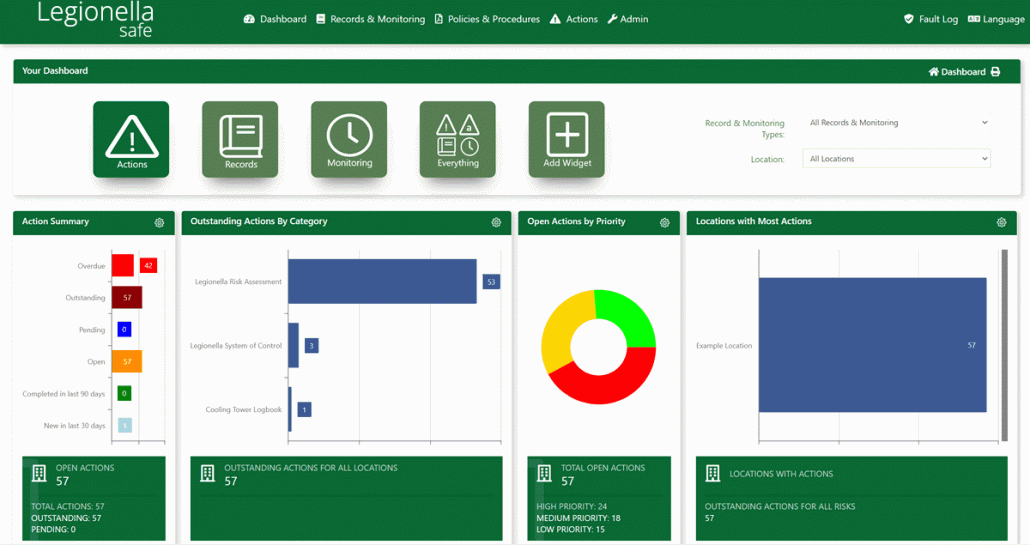Communication and its Role in Preventing Legionnaires’ Outbreaks
 This article examines the impact of poor communication between those responsible for the control of Legionella bacteria in the workplace, i.e. the Duty Holder, Responsible Person, key contractors and other important parties. It highlights how a detailed understanding of such failings can be used to modify behaviours to prevent future outbreaks of Legionnaires’ disease.
This article examines the impact of poor communication between those responsible for the control of Legionella bacteria in the workplace, i.e. the Duty Holder, Responsible Person, key contractors and other important parties. It highlights how a detailed understanding of such failings can be used to modify behaviours to prevent future outbreaks of Legionnaires’ disease.
In this, the first of our series of 5 articles we consider the key failings highlighted by the Health and Safety Executive in their report examining one of the UK’s largest and most high profile outbreaks of Legionnaires’ disease that occurred in Barrow in Furness, August 2002.
A version of this article examining the impact of poor communication on the likelihood of outbreaks of Legionnaires’ disease first appeared in Legionella Control International’s newsletter. To get it in your inbox, sign up for free here.
Legionnaires’ disease from town centre cooling tower
In 2002, a public arts and leisure centre in Barrow in Furness, a town in north-west England was at the centre of one of the UK’s most serious outbreaks of Legionnaires’ disease. The outbreak led to the deaths of seven people, while a further 180 people fell ill.
Upon detailed inspection by safety regulators, an evaporative air conditioning unit installed at the council run leisure centre was found to have caused the outbreak. It had not been properly maintained, allowing Legionella bacteria to multiply to dangerous levels within it. The bacteria were then spread through the air via fine water droplets (called aerosols), which were inhaled by passers-by and those in the vicinity.
poor communication meant health and safety controls were not working and the risks from Legionella were uncontrolled
While the incident led to a long court trial in which breaches of the Health and Safety at Work etc. Act were noted, much has been learned by everyone who kept track of the proceedings. Shortly after, the Health and Safety Executive (HSE) published their report into the outbreak, which ran to 62 pages. The outbreak serves as a sobering reminder of how things can go badly wrong – what can be learned and what can be done to prevent it happening again.
This is the first of five articles exploring key failures that led to the Legionnaires’ outbreak in 2002. It is hoped that by considering what went wrong, others can learn from those errors and prevent anything similar from happening in future.

Communication failings allowed Legionella bacteria to reach dangerous levels
Communication between those key people, and contractors tasked with responsibility for the safety and health of others is essential, and this applies when considering how to manage the risks from Legionella bacteria, and indeed other waterborne bacteria, within a hot or cold water system. The HSE investigation in to the outbreak found that there was poor communication between various people in Barrow Borough Council. This meant that the required health and safety controls were not working and the risks from Legionella were uncontrolled.
It was noted in the report that various levels of management within the Council were not always aware of what other people were doing. This led to a situation where important tasks were missed, because different people assumed other individuals were handling something, rather than double checking this was indeed the case.
Recommendations set out by the report suggested that written communication was a good tool to use to keep track of what is happening with regard to the control of Legionella, and who is doing what and when. It also means there is written evidence of communications between different people. Face-to-face discussions were also noted as a good way of making sure everyone was aware of the situation. The HSE highlighted how various communication tools could be used to make sure all levels of management were aware of what was happening.
Their recommendations also suggested that business leaders must be kept informed of what is happening regarding important health and safety issues – including tackling Legionella risks. Everyone must understand the situation, their obligations, recognise the potential risks and know what is expected of them, and the role they will play.

Unclear lines of responsibility added to the lack of Legionella control
A lack of clarity over lines of responsibility was seen as part of the overall failure to communicate effectively, mentioned in the report from the HSE. The report noted that it was the responsibility of the Council to make sure someone was appointed to take responsibility for the management of the air conditioning unit and its water systems – this person is usually referred to as the Responsible Person.
The Responsible Person who is appointed should have relevant experience and knowledge that would help them perform their duties as the person responsible. It is not enough to simply appoint anyone, as someone without relevant experience will not be able to recognise the risks associated with the air conditioning unit, or other water systems. The responsible person must be able to identify the risks, and then supervise the water treatment processes and make sure all preventative measures are in place to keep people safe.
It’s easy to see how a lack of communication also led to the difficulties in identifying who was responsible for what.
How can we learn from the failures identified in the HSEs Barrow report?
Communication is key here, as everyone must be aware of how to approach health and safety requirements. Legionella is preventable, it can be controlled and kept in check, to prevent this dangerous bacterium from multiplying and colonising a water system. This did not happen in the lead up to the Barrow outbreak, and the bacteria was spread via the poorly maintained air conditioning unit and inhaled by many people.
Under UK law it is the responsibility of an organisation or business of any size to identify who is responsible for health and safety, and who is responsible for tackling Legionella risks. Starting with a clear health and safety policy is of paramount importance, since this provides the backbone that gives strength to all the required measures that will need to be taken to keep people safe.
Ignorance of the law can lead to outbreaks of Legionnaires’ disease – and it is exactly this that should be avoided. A pro-active approach can reduce the chances of dangerous waterborne bacteria taking control of a water system. If there are multiple levels of management or responsibility within an organisation, it should be made clear who is responsible for what, and how communication must take place.
Business leaders cannot remain in the dark about health and safety matters, such as the approach to combatting Legionella in building water systems. They should be pro-active and ensure they are always aware of what is happening. The same applies to everyone down the chain of command.
Businesses must appoint a Duty Holder and Responsible Person to manage Legionella risk
It is imperative that someone is given responsibility for health and safety within an organisation – the Responsible Person. It is possible for that responsible person to hire a third-party provider of Legionella prevention services, but they will still be responsible for hiring someone who is suitable (and competent) for the role.
The bottom line is that no matter the type of business or venue, and no matter the complexity of the management structure behind it, everyone has responsibility for making sure the safety systems in place are robust and sufficient to keep people safe. Those at the top of the tree cannot assume others are taking on roles and responsibilities – they must know for sure what is happening and when.

This comes back to clear lines of communication. It’s easy to see how things can swiftly go wrong if there are no clearly defined roles and responsibilities, and no means of communication is in place between the various people in the business. It is never enough to assume different people are aware of things, not least when it involves health and safety and the prevention of Legionnaires’ disease.
In future articles, we’ll cover the other failings that were brought to the surface during the HSE investigation about the 2002 outbreak of Legionnaires’ in Barrow in Furness. We cannot change what happened, but we can ensure that nothing like it ever happens again.
World leading Legionella control specialists
Legionella Control International help business owners and those responsible for Legionella and water safety in the workplace. Our water management solutions support duty holders, the responsible person and others with responsibility for the control of waterborne pathogens including Legionella bacteria; helping them to protect staff, customers and others and so meet their legal and wider stakeholder responsibilities in this specialist area.
We deliver a full range of specialist services including legionella risk assessments, water sampling and testing, independent compliance auditing, City & Guilds training, Authorising Engineer (Water) services, expert witness support and other environmental risk management services that help keep people safe.
To speak with one of our legionella safety specialists call us today on 0330 223 36 86 or contact us here …


